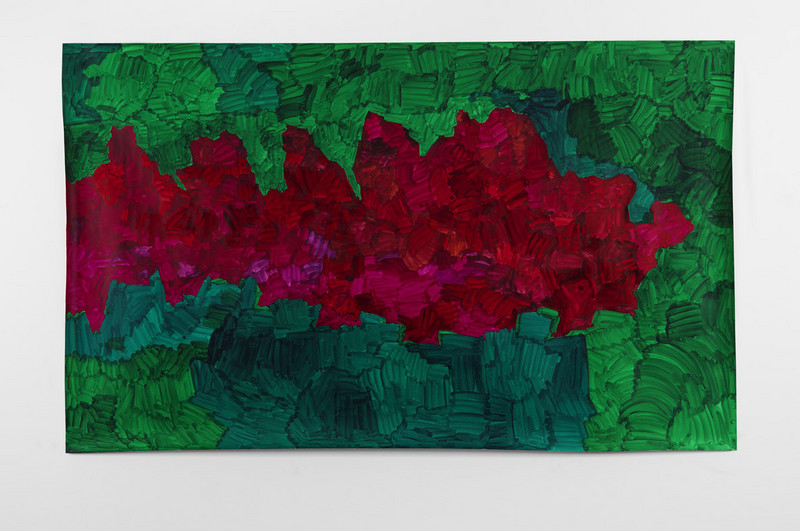Koo Jeong A : Annual Journey
22 Apr - 29 May 2015

Koo Jeong A, Miraculous Efficacy, 2013. Watercolour on paper, 247.8 x 150.5 cm (unframed). Courtesy of the artist and Pilar Corrias Gallery.
Koo Jeong A will present a new series of large watercolour paintings depicting various large rock formations for her second solo exhibition, Annual Journey at Pilar Corrias Gallery. These new works are a continuation from Koo’s 2013 work Consciousness Dilatation that was commissioned for the Real DMZ Project 2013, a contemporary art project based on research conducted on the demilitarized zone (DMZ) separating North and South Korea.
Consciousness Dilatation comprised an installation of various sized basalt rocks, which Koo had collected together with local residents from the fields surrounding Cheorwon, a small military town just South of the border. The rocks were then spread in a constellation-like form across the DMZ Peace Plaza. The constellation format was key as there is no beginning or end within it, instead it is all about how elements connect and relate to one another – both through the material and metaphorical stratification of the existing rice fields and rocks, the memory of the Korean War, and the DMZ as an ecological park.
According to the Ramsar Convention, the DMZ is a protected conservation wetland. As the Korean War led to the division of the Korean Peninsula, the subsequent demarcation of the DMZ as zone of geological and ecological resources between the two countries means that no ecological material can leave the zone. For Koo this state also creates a type of void. It is the void, or the space in between the rocks, that contains their power.
Known for her minimal and poetic installations, Koo makes works that are seemingly casual, yet at the same time remarkably precise, deliberate, and considered. In these new large scale watercolour paintings Koo returns again to the rocks and what they symbolize to her, capturing smaller voids and, from the larger constellation, the relationships that exist between the basalt rocks. The element of air and the invisible force of the winds is key to Eastern philosophy - the paintings start from the depiction of the air, which is drawn first in strong colorful brushstrokes and surrounds the density that the rocks inhabit.
For Koo the void is a metaphoric matter. The artist quotes Alejandro Zambra’s short novel Bonsai (2011), which considers the void in a similar way. At the end of the story the lead character Julio learns how to glide the void by taking a taxi and asking the driver to drive in any direction until his time is up on the meter. The void is the unknown and infinite possibility.
Consciousness Dilatation comprised an installation of various sized basalt rocks, which Koo had collected together with local residents from the fields surrounding Cheorwon, a small military town just South of the border. The rocks were then spread in a constellation-like form across the DMZ Peace Plaza. The constellation format was key as there is no beginning or end within it, instead it is all about how elements connect and relate to one another – both through the material and metaphorical stratification of the existing rice fields and rocks, the memory of the Korean War, and the DMZ as an ecological park.
According to the Ramsar Convention, the DMZ is a protected conservation wetland. As the Korean War led to the division of the Korean Peninsula, the subsequent demarcation of the DMZ as zone of geological and ecological resources between the two countries means that no ecological material can leave the zone. For Koo this state also creates a type of void. It is the void, or the space in between the rocks, that contains their power.
Known for her minimal and poetic installations, Koo makes works that are seemingly casual, yet at the same time remarkably precise, deliberate, and considered. In these new large scale watercolour paintings Koo returns again to the rocks and what they symbolize to her, capturing smaller voids and, from the larger constellation, the relationships that exist between the basalt rocks. The element of air and the invisible force of the winds is key to Eastern philosophy - the paintings start from the depiction of the air, which is drawn first in strong colorful brushstrokes and surrounds the density that the rocks inhabit.
For Koo the void is a metaphoric matter. The artist quotes Alejandro Zambra’s short novel Bonsai (2011), which considers the void in a similar way. At the end of the story the lead character Julio learns how to glide the void by taking a taxi and asking the driver to drive in any direction until his time is up on the meter. The void is the unknown and infinite possibility.
